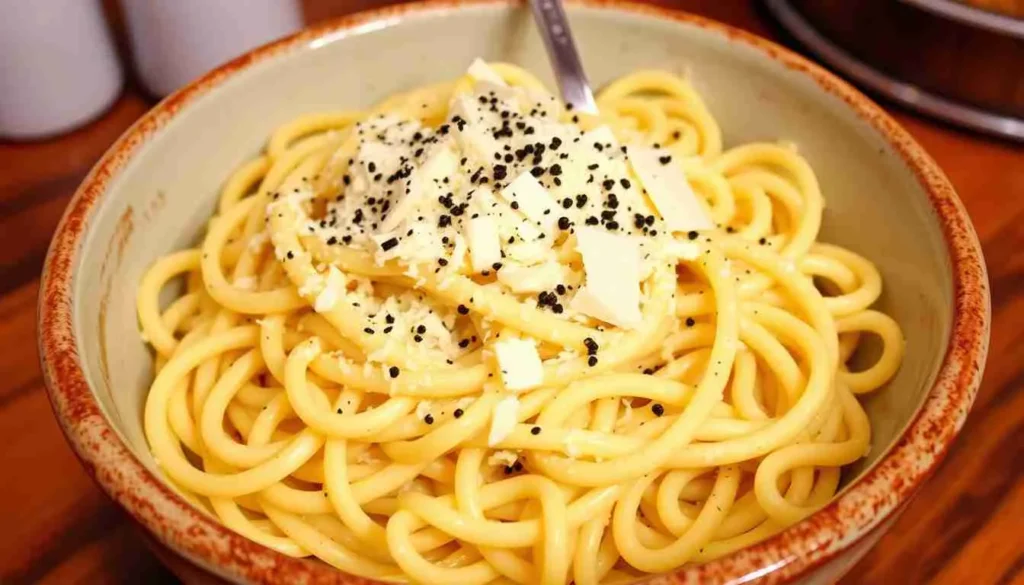Cacio e Pepe: The Quintessential Roman Pasta Dish

Cacio e Pepe, translating to “cheese and pepper,” is a Roman classic that exemplifies the beauty of minimalist cooking. With only three primary ingredients—pasta, Pecorino Romano cheese, and black pepper—this dish transforms simple pantry staples into a creamy, savory masterpiece. A staple of Lazio cuisine, Cacio e Pepe is beloved for its bold flavors and elegant simplicity, making it a favorite in both home kitchens and fine dining establishments.
The Origins of Cacio e Pepe
Cacio e Pepe has its roots in the Lazio region of Italy, where it has been a culinary staple for centuries. The dish originated as a hearty meal for shepherds, who carried Pecorino Romano, dried pasta, and black pepper as non-perishable staples during their journeys. These ingredients were easy to transport and combined to create a satisfying and nutritious dish. Over time, Cacio e Pepe evolved from a shepherd’s sustenance to a celebrated Roman delicacy.
The Key Ingredients
The simplicity of Cacio e Pepe demands the highest quality ingredients to ensure its flavors shine. Each element plays a crucial role in achieving the dish’s iconic taste and texture:
- Pasta: Traditionally, tonnarelli (a thick, square-shaped spaghetti) is used, but spaghetti or bucatini are excellent alternatives.
- Pecorino Romano Cheese: A salty, tangy sheep’s milk cheese that forms the creamy base of the sauce.
- Black Pepper: Freshly cracked black pepper provides a warm, aromatic kick, balancing the cheese’s richness.
- Pasta Water: The starchy water left from cooking the pasta acts as a natural emulsifier, helping to create the creamy sauce.
How to Make Cacio e Pepe
Ingredients (Serves 4):
- 400g (14 oz) pasta (tonnarelli, spaghetti, or bucatini)
- 1 cup Pecorino Romano cheese, finely grated
- 2 teaspoons freshly cracked black pepper
- Salt for the pasta water
Instructions:
- Cook the Pasta
- Bring a large pot of salted water to a boil. Add the pasta and cook until al dente, according to the package instructions. Reserve 1-2 cups of the starchy pasta water before draining.
- Toast the Black Pepper
- In a large skillet or pan, toast the cracked black pepper over medium heat until fragrant, about 1-2 minutes. This step enhances the pepper’s flavor.
- Create the Sauce Base
- Add a ladleful of the reserved pasta water to the skillet with the toasted black pepper. Stir to combine and create a pepper-infused liquid.
- Incorporate the Cheese
- Remove the skillet from heat and gradually stir in the grated Pecorino Romano, mixing vigorously to create a creamy sauce. Add more pasta water as needed to achieve the desired consistency.
- Combine Pasta and Sauce
- Add the cooked pasta to the skillet and toss to coat evenly in the cheese and pepper sauce. The pasta should be fully coated with a glossy, creamy layer.
- Serve Immediately
- Plate the Cacio e Pepe and garnish with additional Pecorino Romano and a sprinkle of black pepper. Serve hot for the best flavor and texture.
Tips for Perfect Cacio e Pepe
- Grate the Cheese Finely: Finely grated Pecorino Romano melts more easily, ensuring a smooth sauce.
- Use Freshly Cracked Pepper: Pre-ground pepper lacks the intensity and aroma of freshly cracked black pepper.
- Reserve Plenty of Pasta Water: The starchy water is essential for emulsifying the sauce and achieving the creamy texture.
- Work Quickly: Cacio e Pepe requires quick mixing to prevent the cheese from clumping. Prepare all ingredients in advance to streamline the process.
- Avoid Overheating: Remove the skillet from heat before adding the cheese to prevent it from seizing or becoming grainy.
Variations of Cacio e Pepe
While the traditional recipe is revered for its simplicity, creative adaptations can add new dimensions to the dish:
- Cacio e Pepe with Lemon
- Add a splash of lemon juice or zest for a bright, citrusy twist.
- Cacio e Pepe with Vegetables
- Incorporate sautéed zucchini, asparagus, or peas for added texture and freshness.
- Cacio e Pepe with Truffle
- Drizzle truffle oil or shave fresh truffle over the pasta for a luxurious touch.
- Cacio e Pepe with Different Cheeses
- Experiment with aged Parmesan or Grana Padano for a milder flavor profile.
Cultural Significance
Cacio e Pepe is more than just a dish; it’s a symbol of Roman culinary tradition. Its humble origins and enduring popularity reflect Italy’s love for simple, high-quality food. Whether enjoyed in a bustling Roman trattoria or a quiet home kitchen, Cacio e Pepe connects diners to centuries of Italian history and culture.
Pairing Suggestions
To enhance your Cacio e Pepe experience, consider these complementary pairings:
- Salad: A fresh arugula salad with lemon vinaigrette provides a refreshing contrast.
- Bread: Serve with crusty Italian bread to soak up any leftover sauce.
- Dessert: End the meal with a classic Italian dessert like panna cotta or tiramisu.